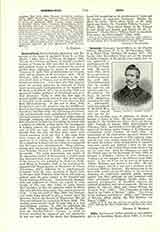

Semmelweis, IGNAZ PHILIPP, physician and discoverer of the cause of puerperal fever, b. at Ofen (Buda), July 1, 1818; d. at Vienna, August 13, 1865. The son of a German merchant, he became a medical student at Vienna in 1837, and after he had taken a philosophical course at Pesth, continued his medical studies there, obtaining his degree in medicine at Vienna on April 21, 1844, as obstetrician on August 1, 1844, and as surgeon on November 30, 1845. On February 27, 1846, he was made assistant at the first obstetrical clinic of Vienna, and on October 10, 1850, lecturer on obstetrics. A few days after this appointment, for reasons unknown, he removed to Pesth where he was made head physician at the hospital of St. Roch on March 20, 1851, and on July 18, 1852, was appointed regular professor of theoretical and practical obstetrics. Early in 1865 the first signs of mental trouble appeared, and on July 31 he was taken to the public insane asylum near Vienna where he died from blood-poisoning. At the end of May, 1847, Semmelweis made the assertion that the terrible endemic at the Vienna hospital among lying-in women was caused by infection from the examining physicians, who had previously made pathological dissections, or who had come into contact with dead bodies without thorough cleansing afterwards. After Semmelweis had introduced the practice of washing the hands with a solution of chloride of lime before the examination of lying-in women, the mortality sank from 18 per cent to 2.45 per cent. He also soon formed the opinion that not only infection from septic virus caused puerperal fever but that it also came from other causes of putridity. His dislike of public speaking or of writing was probably the cause why the recognition he deserved was so long in coming and why his views were misunderstood. Many scholars, among them the doctors of the Academy of Paris and even Rudolph Virchow at Berlin, regarded him unfavorably. The petty persecution and malice of his opponents excited in Semmelweis a sensitiveness that increased from year to year. The first account of his discovery was published by Professor Ferdinand Hebra in December, 1847, in the journal of the Imperial and Royal Society of Physicians of Vienna (December, 1847), followed by a supplementary statement from the same physician in April, 1848. In October, 1849, Professor Josef Skoda delivered an address upon the same subject in the Imperial and Royal Academy of Sciences. Unfortunately, Semmelweis had neglected to correct the papers of these friends of his, and thus failed to make known their mistakes, so that the inference might be drawn that only infection from septic virus caused puerperal fever. It was not until May 15, 1850, that Semmelweis could bring himself to give a lecture upon his discovery before the Society of Physicians; this address was followed by a second on June 18, 1850. The medical press noticed these lectures only in a very unsatisfactory manner. In 1861 he published his work: “Die Aetiologie, der Begriff and die Prophylaxis des Kindbettfiebers” (Vienna), in which he bitterly attacked his supposed and real opponents. It was not until after his death that Semmelweis found full recognition as the predecessor of Lister and the pioneer in antiseptic treatment. Besides the above he wrote: “Zwei offene Briefe an Dr. Josef Spath and Hofrat Dr. Friedrich Wilhelm Scanzoni” (Pesth, 1861); “Zwei offene Briefe an Dr. Eduard Kaspar Jakob von Siebold and Hofrat Dr. Fr. W. Scanzoni” (Pesth, 1861); “Offener Brief an samtliche Professoren der Geburtshiefe” (Ofen, 1862).
LEOPOLD SENFELDER

